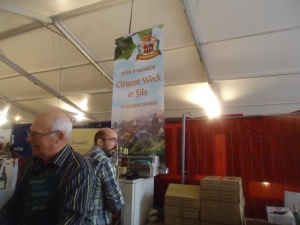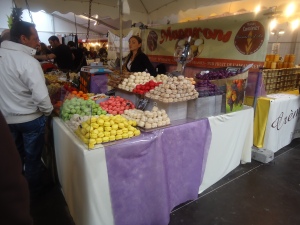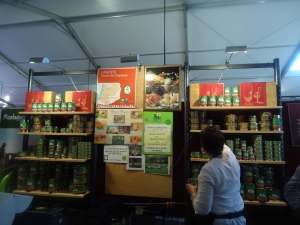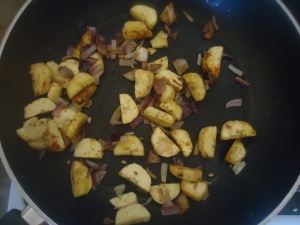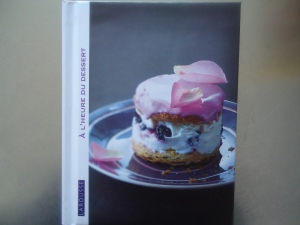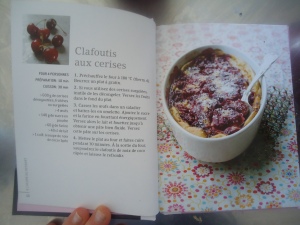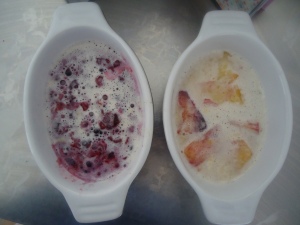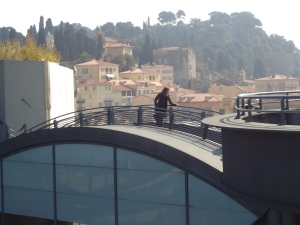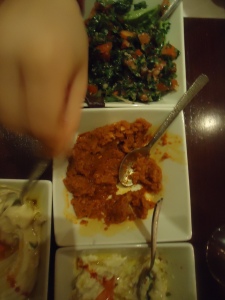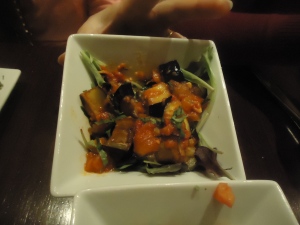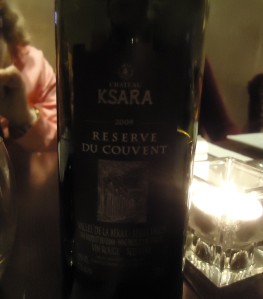While I’m still fighting with wordpress and my new host, I’d like to remind everyone who’d like to, to resubscribe to hollyeatsinfrance.com. My old subscribers were lost and that makes me sad. I promise I won’t bombard you with emails, I just wanted to get the word out. Thanks!
So today, after much frantic and terrifying experiences that included screaming, yelling at cats, swallowing a tortilla chip whole and almost losing this blog, I have moved web hosts. Which was intentional, but I’d never done it before.
Anyway: Same address, same crazy adventures in food and France with a glass of wine, the husbands and two cats who will miss you-
Unless! you resubscribe, so please join me at hollyeatsinfrance.com to continue the adventure!
Hope to see you there!
 Bacchus: the Greek god of wine and drunkenness. His spirit has visited Toulon at the beginning of every spring, and for the last three years (since I’ve moved to France) it has become part of our tradition as well.
Bacchus: the Greek god of wine and drunkenness. His spirit has visited Toulon at the beginning of every spring, and for the last three years (since I’ve moved to France) it has become part of our tradition as well.
The Fête de Bacchus is a wine event that the husband and I look forward to in order to replenish our stock of good wines for the spring and summer months, while patiently waiting for the foire aux vins that happens all over France in September. For three days, Friday to Sunday the big white tent is erected in Place d’Arms in the center of the city, and the wine makers, sellers, and connoisseurs come rolling in every morning from all over France to peddle their noble fare. They open their stands at 10am and the place is packed by 10:30.
Bottles are uncorked and lined up. Let the tasting begin.
We had a list of what we wanted this year. Chateauneuf Domaine du Rempart had returned and we made our usual purchase of their 2005 and 2001, both excellent years with very different characters. The 2005 we’ll be drinking this summer with something humble but heavy on a stormy day. The 2001, a deeper wine that needs to be aired, enjoyed, sipped along side something like boar will be saved for December.
Alsace wines are always a big purchase for us at any foire aux vins. Sure, you can buy Rieslings and Pinot Gris in the supermarkets here, but the wines from the smaller producers that come to Bacchus have much more flavor, as complex as they are subtle. We bought one of each – the Riesling, the Pinot Gris and a Gewurztraminer each with a different undertone and melody. The Riesling is dry and lemony, the Pinot Gris a bit spicy and the Gewurztraminer is soft and peachy.
There were two discoveries this year. As I’m looking to continue my studies in gastronomy at a school in the Anjou region, I insisted that we take a taste of the Angevin wines. Our first taste was of an older variety of grape the Grolleau noir which neither the husband nor I had ever heard of, let alone tasted. The producer told us it was a grape that was “out of fashion” at the moment having been replaced by the Cabernet.
A interesting scent hit our noses when we took a sniff. “It smells like a light, creamy cheese,” the husband said. I was relieved, I thought my nose was playing tricks. The taste was oddly the same. A very fruity flavor, but with a creamy taste that reminded us of, yes, a creamy cheese spread with some sort of berry sauce. According to some wine experts, all the Grolleau vines should be ripped up and replaced with something with more potential, but I am interested in opening this bottle and tasting the strange flavor again to make my final decision. Maybe it doesn’t have aging potential, but neither do I.
By this point we were hungry and a bit tipsy and our tongues were incapable of tasting further. It was time for a snack.
Of sausage.
At any wine tasting event, there are always produit du terroir, because you can’t buy wine without being inspired by the food. Or vice versa. Mushrooms, macaroons, cheeses, foie gras, sausages; they were all out in force.
On our way through the meat and cheese section we came upon a lone wine stand. It was odd to see this one separate from the others of its kind until we looked closer. It wasn’t just wine- it was hypocras.
I was excited. Ever since I first tasted this medieval beverage at Château Trigance a few years ago, I’ve loved having it as an aperitif, but it’s not something that’s easy to find. La Cuvée des Elfes had many varieties, hypocras flavored with rose, raspberries, even pepper. It was the last one that we purchased and promised the producer that we’d check out his website in case we wanted to order some more at a future date.
There was more tasting. Many of the vendors themselves were nipping at their own glasses between lulls of customers and curious tasters.
There was a lull for us too, as we had lunch at the local Japanese restaurant – and I continued my tasting with one of the biggest glasses of a local red I’ve never needed.
When we got home I rounded up the bottles and looked them over. Three whites, an Angevin rosé with a flavor completely different from that of their Provencal cousins, one hypocras, two Chateuneuf, our Anjou red and a nice Saint Emilion 2007 – a red Bordeaux that is fast becoming my favorite of the region. We won’t be going thirsty this season.
All in all, it was a festive morning and afternoon devoted to the grape. Confrères were wearing their ceremonial robes and medals in honor of the occasion – this is the twenty year anniversary after all – and we humble consumers were mostly drunk by noon. Just at Bacchus intended.
If you were going to move to another country where you couldn’t speak the language that well, what is the one non-obvious but absolutely essential thing you need to know?
For me it was having my hair cut and dyed for the first time. It was a comic-tragedy with that rare happy-ending with me, the husband, and the hair dresser trying to figure out what I wanted and how to say it in French. The end result was perfect and I love my new hair-dresser, but it was a nerve wracking hour hoping she wasn’t going to dye my hair that horrible shade of purple-red so loved by the old women here.
These are the types of things no one thinks about. You move to another country and say to yourself “I can buy bread and order wine, what more do I need?” Then you come down with a skin rash and have to open a savings account and jolt up in bed one night at 3am thinking “I don’t know the word for savings account in <insert language here>.”
I’m talking about past experiences of course, but as I prepare one of my own students for a future move to England, I am wracking my brain trying to think of things she NEEDS to know or there will be somewhat tragic consequences.
The word for laundry detergent vs the word for fabric softener. Yeah, for a month our clothes were super soft, but no cleaner until the husband looked at the bottle and saw the mistake I’d made on my last purchase
It will be summer soon. All of Europe and some of the US will be descending on Provence. If I could give you some advice before you depart for your vacation, I’d probably scare you away. But today, I’d like to warn you, or at least give you a preview of the trains.
Once, I have no doubt that traveling by train was a pleasant experience, possibly easy and comfortable, and in reality, it’s not actually a bad experience today. But romantic? Not so much. The glamor is gone.
Trains are few and far between, and that’s when SNCF is NOT on strike which happens about once a month. The trains themselves are cold, dirty and covered in graffiti inside and out. They do their jobs well enough, and I have no complaints, but be careful of wet marker if you lean against a wall.
The above is one of the few trains I saw on my sojourn Monday and the only one not covered in graffiti – through there is a little on the top you can see.
 There’s the train stations themselves. In the small towns of Provence on route between Toulon and Marseille the stations are quaint, abandoned, quiet. When it’s warm out, it’s a pleasant place to eat lunch while you wait for your train.
There’s the train stations themselves. In the small towns of Provence on route between Toulon and Marseille the stations are quaint, abandoned, quiet. When it’s warm out, it’s a pleasant place to eat lunch while you wait for your train.
Looks cute huh?
Until you realize you have a two hour wait because SNCF is on strike and the trains are all delayed and there’s not a toilet for miles.
Some people go in the bushes. I do the potty-dance.
Now, I don’t want to discourage people from taking the local trains (Don’t get it  confused with the TGV). The view is often enjoyable and when the trains are on time they are a relaxing way to travel. But I suggest traveling with a cat in your bag to be safe. Go to the bathroom before you leave and drink water sparingly. And that weird old fridge smell on the train is just the air conditioning, I promise.
confused with the TGV). The view is often enjoyable and when the trains are on time they are a relaxing way to travel. But I suggest traveling with a cat in your bag to be safe. Go to the bathroom before you leave and drink water sparingly. And that weird old fridge smell on the train is just the air conditioning, I promise.
Before we begin, if you’re squeamish about your meat or have a moral aversion to what butchers do you may want to avoid this entry.
Sunday, I finally had my quail. We ordered them on Thursday and being super excited I planned and dreamed the rest of the week for what I was going to stuff them with and prepare as a side to these little birds. Saturday night I was ready. I instructed the husband as to what I needed at the market when he went to pick them up the next day. I went for my morning Sunday run and when I came home, I walked in the door and said, “Les cailles?”
“Yup,” the husband said.
Quail or caille are very little birds of mostly bones and a meat that is somewhere between white and dark. Each one was under 200 grams. They were delivered all tied up with their little limbs packed close to their bodies. I took them out of their wrappings and cut away the string and then I saw something shocking.
Heads.
I called to the husband, “My cailles still have heads on them.” I should have expected it. We hadn’t specified to the butcher to prepare the birds for me before we picked them up. But it was unexpected and very alarming. Not only did they have their heads, but this also meant that my quail also still had all their little organs inside, fully attached.
Have you ever prepared a turkey for Thanksgiving or Christmas? Did it have it’s head? Never in my life have I had to clean out a turkey, quail, or any bird, let alone decapitate one. Of course, you can buy a turkey that hasn’t been – shall we say – emptied, but usually the organs are detached from the body and wrapped up separated for use or for discarding. I stared down at the little heads, thankfully, their eyes didn’t seem to be staring back.
I grabbed my very big meat knife. Took a deep breath. Then another deep breath. And then – Off with their heads!
And out with their organs. It was disturbing. But I feel like I’ve hit a milestone in my amateur chef-ness. I have decapitated an already dead animal.
With that out of the way, I had to prepare my stuffing. I kept it simple and traditional for the first time around. Mushrooms in cream with garlic onions and some herbs.
Roasted Quail with Creamy Mushroom Stuffing
- 2 quail of about 200 grams each
- 350 grams wild mushrooms (cèpe, girolles, morels, chanterelles etc)
- 1 yellow onion
- 3 cloves garlic
- 2 celery ribs
- 75 ml heavy cream (or about 4 tablespoons)
- olive oil
- chicken broth or stock
- sage
- thyme
Preheat your oven to 180°C.
Clean your quail out of any organs. Set aside.
I really recommend yellow onion here as the yellow onion has a buttery scent and attack when it first hits your tongue – perfect for this type of stuffing. Mince your onion, garlic, celery. In a heated frying pan with a little bit of oil, cook over medium heat until the onions and garlic are fragrant, a minute or two. Add your mushrooms. I used frozen mushrooms which took about 10 minutes to cook and mix with the rest of the veggies. Add your heavy cream and herbs and mix until everything is warmed and fragrant. Salt and pepper to taste.
Keep warm but set aside while you prepare the quail.
Prepare a medium size casserole dish for roasting your quail the way you would roast a turkey. I simply put a little chicken broth at the bottom. No more than ¼ cup. Rub a little olive oil, salt and pepper into the quail.
Stuff the birds full of the stuffing and wrap up so that the stuffing can’t fall out while baking. I tied the legs of my quail together, but didn’t go any further than that because I didn’t have a needle to sew them shut. Careful when you stuff your quail because they are slippery from the oil and easy to squeeze – stuffing falls out everywhere if you squeeze too hard. This isn’t your typical stuffing either. There’s no bread, obviously, and though the cream will thicken as it sits, it doesn’t stick like traditional stuffing. So take care when you fill your birds.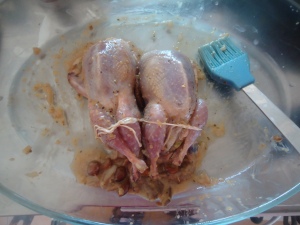
With a basting brush, rub stock over the birds and then put in the oven. Bake for 20-30 minutes until bird is fully cooked and the skin is golden brown. Baste every 5-8 minutes or so for optimal moisture. Remember that these are birds just like chicken or turkey, but they do tend to have a bit of extra tenderness to them.
Serve immediately with extra stuffing. I added a handful of chopped walnuts to the stuffing.
As a side we had sweet potato “hash browns” which I’m only calling hash-browns because I cooked them in a pan with onion, garlic, and parsely instead of roasting them. They added a colorful and comforting texture to the plate as well as having a sweet taste that off-set the savory quail.
So how were they, the birds? Perfect. Quail, when roasted right have a moist, tender flesh with a buttery flavor. It’s not like the dark meat of the turkey – softer, lighter, a bit more wild, which went perfect with the wild mushrooms and cream.
Don’t like quail? No problem.
Strawberries have arrived! We had a very warm winter and with it came an early spring and the first strawberries are here. We had them for dessert sprinkled with lemon juice and tiny sprinkling of sugar and basil. Light, fresh and sweet. And no heads in sight.
 I know that I promised you quail. Stuffed quail to be exact. But due to a glitch with our butcher’s bird supplier, the quail won’t be coming until Sunday. Apparently, when he ordered caille (French for quail) that some how translated to canard (duck) and the delivery last Saturday included two ducks instead of two quail. I love duck, but I didn’t need two of them. This weekend, he promised us, he’d go pick up the quail personally. We’ll see. I think he knew I was so disappointed.
I know that I promised you quail. Stuffed quail to be exact. But due to a glitch with our butcher’s bird supplier, the quail won’t be coming until Sunday. Apparently, when he ordered caille (French for quail) that some how translated to canard (duck) and the delivery last Saturday included two ducks instead of two quail. I love duck, but I didn’t need two of them. This weekend, he promised us, he’d go pick up the quail personally. We’ll see. I think he knew I was so disappointed.
In the meantime, I give you a Français-Sud Américain blend for lunch. Red Bean Plantain Empanadas with Tomato Mozzarella Salad.
I’d been thinking about empanadas for some time. They just sounded fun. Simple – only a few ingredients are in the filling. Hot – baked in the oven. With a crust. I love crunchy crusts. I’m a pie-without-the-pie-filling kind of girl. It’s weird.
Why red beans you ask? Well, I have looked EVERYWHERE – in fact in every market and grocery I go to, I still look – and I cannot find black beans anywhere. If you live in Provence and know of a place that sells black beans let me know. Or, if you’re feeling generous and live in the States, I haven’t lost anything in the mail yet.
There are many different recipes out there for empanada dough. But I was feeling lazy and simply bought two pâte brisée, which are close enough. That’s the French twist to these I guess.
Red Bean Plantain Empanadas
(Makes 8 LARGE Empanadas)
- 1 can red beans – drained
- 1 plantain
- 1/3 red onion finely chopped
- 1 – 2 cloves of garlic
- ½ tsp of chili powder or to taste (I have super hot chili powder so I have to scale it back a lot)
- ½ tomato finely chopped.
Slice up your plantain. In a heated frying pan with a little bit of oil, sautée your onion, garlic, and plantain until softish – about 8 minutes. Lower heat. Add beans, tomato, and chili powder. Cook until heated, then remove from heat immediately. Mix and mash up the plantains a bit. This is really just a texture thing and to get a good blend of plantain-bean in your filling. It’s entirely unnecessary.
Roll out your dough.
Here’s where I decided to forget the half-moon shape and just go for ease in presentation. I scooped a generous portion of the bean-plantain mixture onto one of the dough circles in about 7 portions.
Then I laid the other dough on top of it. Used a big coffee mug to mark out my empanadas. Cut the excess away and used it to make one final empanada.
Bake in the oven for 15-20 minutes at 180°C or until golden brown.
You might want to add a little more oil to your filling before making your empanadas for some extra moisture. Or add cream or cheese if you’re like the husband and can’t imagine having something that doesn’t have meat and cheese in it:
“Mexican food has cheese!” He cried. Apparently, he’s the authority despite never having eaten Mexican food until he met me.
“They’re not Mexican,” I told him. “They’re from South America. Some say Peru, some say Argentina.” Actually, I looked it up and they’re originally from Moorish Spain and Portugal.
“Oh,” he said. But I could still hear the unspoken cries of “CHEESE!!!” going around in his head.
Serve your Empanads with something light. Because these babies are deceptively heavy. Tomato salad is a good choice. Simple, fresh, and so colorful.
- 2 tomatoes
- 1/3 red onion
- 1 avocado
- 1/2 can corn
- 1/2 ball of mozzarella
- Salsa verde or dressing of choice (lemon, olive oil, balsamic vinegar, mustard)
Chop all ingredients. Put into a bowl. Mix. Season with salt and pepper. Add a little salsa verde. Mix. Serve.
What is so fabulous about this lunch is that it’s so few ingredients and easy to prepare. Other than putting the empanadas together, it takes little time (around 30 minutes) and there was no stress involved, the way stuffing a quail might be stressful.
Definitely Thursday lunch comfort food. The type of thing you eat on a day off and then lie on the couch after with a cup of coffee trying not to fall asleep, so you type up a blog entry about your lunch that includes a myriad of run-on sentences because you’re so excited about how well your empanadas and tomato salad worked out and how the textures and flavors binded so wonderfully together and yet it was so SIMPLE.
I need more simplicity in my life. But that’s something for another day. Sorry about the run-on sentences and the quail. Here’s hoping Sunday won’t disappoint!
Today was the first day of the year that it was warm enough to eat on the balcony. I didn’t make anything special for it as it was “leftover day,” trying to get rid of all the random stuff in our fridge to make way for more leftovers. I wish that I could portion things properly – like pasta. I know that I can make food and freeze it, but I have this thing about microwaves…
But I digress.
I had my lunch, which was roasted vegetables, tomato, homemade hummus, a slice of Itchebai cheese, and a hunk of crusty bread. Tomato soup. Crystal Light, courtesy of la famille who toted 6 packs of the stuff across the Atlantic at my request. Definitely a leftover day.
What is Itchebai cheese you ask? Well, it is French. Think cheddar with a Swiss twist.
This Christmas someone gave us a box set of small cookbooks on classic French cuisine by Larousse. What is Larousse? Obviously you’ve never had to buy a French dictionary. I was interested in making some sort of fruity pastry for dessert today and turned to the dessert volume for inspiration.
I’ve seen clafoutis in boulangeries here, in the pastry section, looking rather cake-like and fruity. Normally they are done with prunes or cherries. I had neither in the house, but I do have a package of frozen berries and pineapple. The husband is not a fan of fruits rouges.
While, the ones I saw in the shops looked like cake – clafoutis is rather like a flan that has been thickened with flour. Deceptively cake looking, but not cake like. Though I had seen it, I had never tasted, nor baked it, but there’s a first time for everything and if I’m going to live in France and study French cuisine, I better start cooking.
Clafoutis aux (Fruits Rouges ou Ananas)
Adapted from A l’heure du dessert, Larousse:
- 150 grams berries*
- 150 grams pineapple chunks*
- 3 eggs
- 70 grams powdered sugar
- 200 ml milk
- 30 grams flour
*as I mentioned above, cherries or prunes are the most common fruits added to clafoutis, but use any fruit you like. It’s all good.
Preheat your oven to 180°C. If you want to serve this in individual portions break out the ramkins, otherwise find a small size cake tin for four.
If you’re using frozen fruit; which is what I did, you might want to defrost them now. In the meantime, whisk your eggs together in a good size mixing bowl. Add the flour and sugar and whisk again until incorporated. Add the milk and mix until you have a nice, smooth, and fluid batter.
Put your fruit in the bottom of your cake tin or ramkin. There’s no need to grease them.
Pour the batter on top of the fruit.
Bake for 30 minutes.
Let cool and serve.
The original recipe supposedly serves 4. I halved it, but used three eggs instead of two, and it still served four. I guess I like smaller desserts than the editors of Larousse.
I shouldn’t have been surprised, but I was, when the egg batter pushed its way down to the bottom of the pot and forced the fruit to the surface, which created a layered effect I wasn’t expecting.
While I don’t love flan, and clafoutis is not your typical rich, buttery, creamy, French pastry, this was something I could eat again. Not too sweet, comforting, mixed with the tart berry.
Next time I see one in the local bakery I’ll buy it to see how I compare to the professionals, but for now this French classic has won me over with it’s ease and adaptability if nothing else. I sound like an advertisement. Dinner’s just about ready so it must be the hunger talking…
In Nice there are three local street foods you should sample:
- Socca
- Légumes farcis
- Beignet de Cébettes
Socca is a niçoise classic, outdoing the salade niçoise or bouillabaisse which actually comes from Marseille. Made of chickpea flour mixed with water and olive oil and cooked in a wood burning oven like pizza dough, then portioned out on small paper plates to waiting customers. It’s total street food. Salty, a little greasy, fabulous. If you’re in the Var it’s called cade.
Légumes farci is something you’ve seen: simply stuffed vegetables. Usually they are stuffed with beef and bread crumbs and broiled in an oven. You can use onion, zucchini, pepper – all featured in this photo – or eggplant and tomatoes.
Fried scallion lumps. Honestly, I don’t know what else to call them. In French they are called beignet des cébettes. They are scallions chopped and mixed with a thick bread batter then deep fried. I guess some people would called them tempura scallions. Beignet are very common for all vegetables, but the onion are a classic. Onion rings, anyone?
But if you want something a bit sweet, a bit more upscale. Go to Amorino near Place Massena for chocolat chaud or better yet, ice cream.
All natural, all simple, all subtle, creamy and wonderful with a chantilly that is more cream than sugar and so worth it.
Visit the Modern Art Museum. Even if you don’t like modern art there are some cool exhibits. One of a dress made entirely of bottles. I will wear it at my first book signing.
If you’re like the husband and can’t stand the art, race through it to get to the top floor, where you’re rewarded with an excellent view:
Then there’s Carnival. Which takes place every year at the end of February going into March. Parade with devil floats included.
There is always more. There is shopping – of which I did in abundance – I can’t help it, they have a Fossil store. There are plenty of museums, archaeological sites, and landmarks. Nice is one of the oldest cities in Europe and the oldest in France and has a rich history which I will not repeat here so as not to bore you to death.
So in this short overview, I say, “Visit Nice.”
 I spent a long long time trying to decide where we should eat on our last night in Nice. At first, I wanted Italian, then I wanted traditional French, then I wanted Indian, then I wanted Italian again. There was a brief moment of looking at Japanese restaurants, then back to Italian. Everyone else was of no help. No one wanted to make a decision.
I spent a long long time trying to decide where we should eat on our last night in Nice. At first, I wanted Italian, then I wanted traditional French, then I wanted Indian, then I wanted Italian again. There was a brief moment of looking at Japanese restaurants, then back to Italian. Everyone else was of no help. No one wanted to make a decision.
Originally, I had planned for an Italian place that the husband had told me he had liked when he lived in Nice. Except that was 10 years ago and the current reviews – the most current being in 2011 – were very, very mixed. I got nervous and started looking for other places to eat.
At first, I was going to ask them to choose between Italian and whatever else I could find but in the end I just decided for them. Everyone met in the lobby at 7:30 and I asked my mom and sister “Have you ever eaten Lebanese?”
“Not really,” they said.
“Well, that’s what we’re having.”
And off we went to Ya Habibi.
Though the restaurant was only 500 meters from our hotel, I forgot to bring the address and consequently it took us more than 500 meters to find. No matter, we got there. Dinner was decided in moments – a Grand Mezze for four. The perfect treat for two who don’t know Lebanese and for the other two who just love a good mezze.
5 cold entrées and 6 warm entrées with fresh pita bread. It’s as simple as that.
Mezze is pretty standard. Hummus is par for the course along with taboule, babaganoush and grilled caviar d’aubergine. But our favorite of the night was the mehamara – a roasted red pepper spread with garlic, onion and grenadine. Sweet and spicy perfectly blended. We could have eaten that all night.
The six warm entrées were also pretty standard. Samboussi, falafel, roukak, moussaka, arayess lahme, and kebbé with grilled mushrooms.
The samboussi and roukak are fried dumplings the first of meat, the second of cheese. Crunchy and soft, no need for any dipping sauce – they were well seasoned.
I really loved the arayess lahme. A pita stuffed with meat and spices. It must have had some mild cream or cheese in it, because it had a creamy texture and was so delightful.
The moussaka was missing the meat. This was stated in the menu. But it was not missing flavor. We sat around the table trying to figure out how they cooked the eggplant. The flavor was perfect with soft flesh and a crunchy skin. I thought they steamed it. The husband is convinced roasting went on. Who knows?
We drank a wonderful Lebanese red wine, that was mostly syrah and cabernet grapes. It had a fruity aroma but a bitter, acidic taste and the two combined to create a complex enjoyable flavor that made me want to buy a bottle to take home.
Though dinner was simple, it was perfect. Good portion sizes, we were not left wanting. Every dish with a wonderful blend of spices. I have nothing but good things to say about my choice of Ya Hababi for our last dinner in Nice. A lovely treat for the pallet when you’re craving something a little different.
By now, my mom and sister have returned to Boston. We’re all going on a diet, but with happy memories full of good food and time spent together. It’s never enough but it will have to do until the husband and I can get ourselves to the States.





